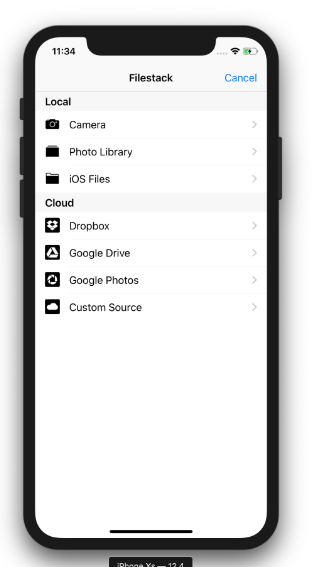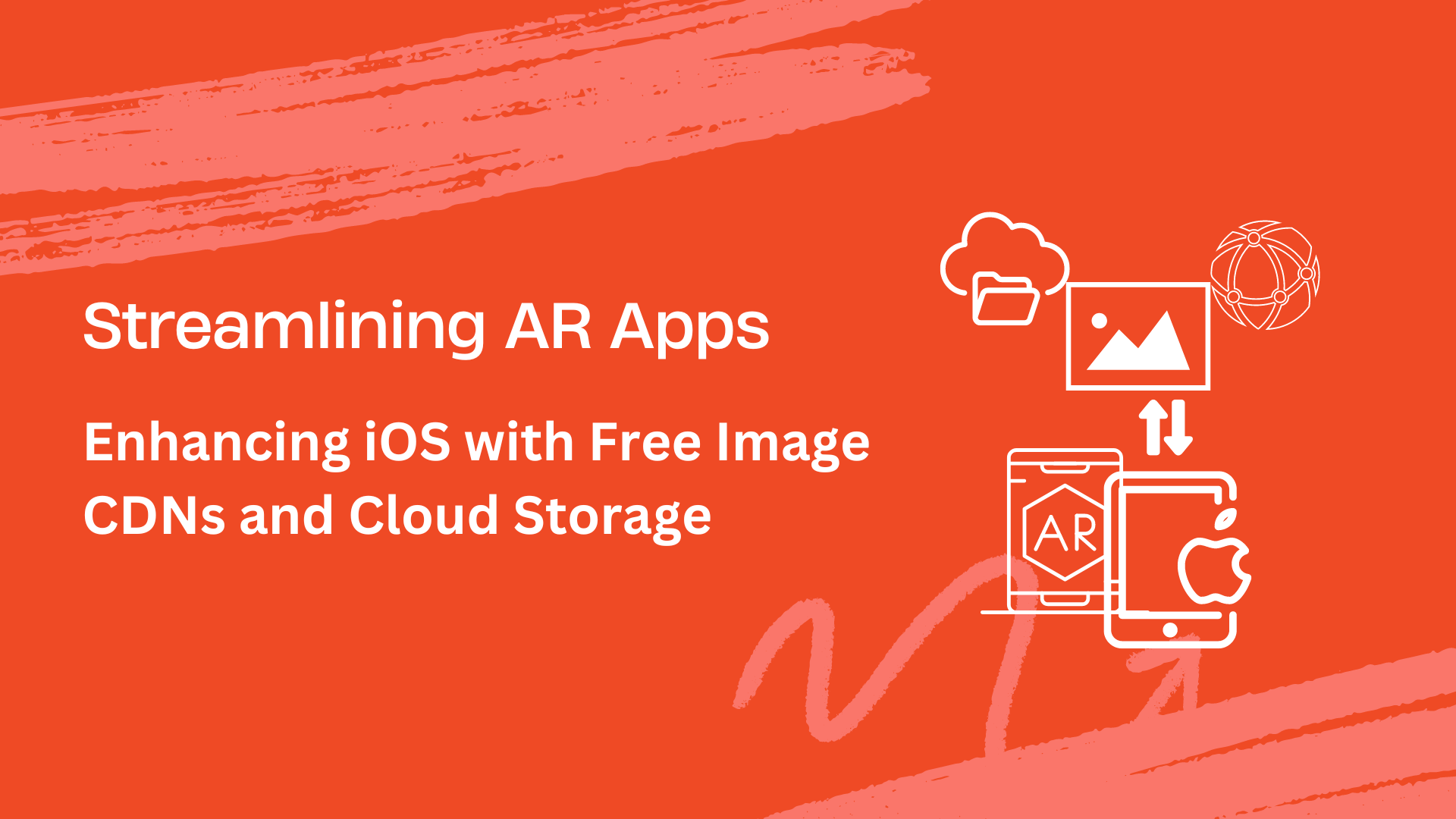Augmented reality (AR) has been a buzzword for the past few years. And for the right reasons. AR is an advanced technology that combines computer-generated virtual objects and digital information with the real-world environment. It enhances the user’s perception of reality by providing a more interactive and immersive experience. The use of AR is prevalent across industries and in various mobile apps, from gaming and entertainment to education, healthcare, and retail. In fact, the mobile AR market reached an estimated worth of US $12.45 billion in 2021. And it is expected to reach around $36 billion by 2026.
However, to provide compelling AR experiences, seamless delivery of real-time content is imperative. This is where the integration of free images CDN and cloud storage solutions in iOS AR apps is beneficial. These technologies enable developers to manage and deliver multimedia assets efficiently. This helps ensure that AR experiences remain dynamic, responsive, and immersive for users.
This article will explore how the integration of augmented reality (AR), cloud storage, and free images CDN in iOS apps facilitates more engaging and immersive AR experiences.
Augmented Reality with Cloud Storage and CDNs

Challenges in developing AR mobile apps
AR involves the integration of the real-world environment/ physical world with the digital world. This is not easy to achieve. Thus, developing AR-based apps is challenging and time-consuming. For instance, these apps must deliver dynamic content and real-time interactions between virtual and physical elements. This includes responsive touch, object recognition, and gesture-based control, which require high bandwidth and rapid content updates through low-latency communication between the app and its backend infrastructure.
AR experiences should also be consistent in time and space. What this means is that an AR experience should remain accessible for users over an extended period without any inconsistencies or changes. For example, virtual elements within the AR experience must remain positioned in the same locations within the real-world environment where they were initially placed.
Moreover, AR apps often need to integrate high-resolution textures and complex 3D models (graphical representation of an object to be displayed in the 3D space). These textures and models require high storage capacity and efficient rendering capabilities to ensure seamless performance.
How cloud storage and CDNs can help provide better AR experiences
A CDN (content delivery network) is basically a globally distributed network of servers and data centres. It caches your app content and stores its copies on several servers worldwide. When a user accesses your app or website, the free CDN delivers the content from the server/data centre nearest to the user, reducing latency.
Cloud storage and free images CDN play a crucial role in creating efficient AR mobile apps that deliver immersive and interactive user experiences:
High-Resolution Textures and 3D Models
Cloud storage solutions provide scalable storage space required for storing large volumes of high-resolution textures and 3D models used in AR apps. Cloud storage also provides quick access to content from anywhere at any time.
Moreover, a free images CDN makes it possible to deliver high-resolution textures and 3D models quickly. It basically caches these assets in strategically located edge computing servers closer to end-users. This reduces latency and significantly increases the content delivery speed. Using CDNs also reduces bandwidth usage costs.
Rapid content updates and real-time interactions
Rapid content update is one of the core requirements of an AR app to ensure real-time interactions. CDNs support rapid content updates by updating content in real-time across their edge servers. This ensures that users always have access to real-time content without any delays or disruptions.
Cloud storage solutions also support real-time interactions by providing scalable storage space for:
- User-generated content
- Session data
- Other dynamic assets.
Developers can easily store and retrieve assets from cloud storage in real-time and manage content dynamically. This allows for seamless AR experiences.
iOS cloud providers for AR apps

There are various cloud storage solutions that you can use for your AR apps. However, it’s important not to confuse these cloud solutions with AR cloud.
Some of the leading cloud storage platforms for iOS apps include:
AWS S3
Amazon S3, or Simple Storage Service, is a popular cloud storage solution provided by AWS. It provides highly scalable cloud storage that can handle large volumes of AR content.
Additionally, AWS S3 offers robust security features. These include access controls, encryption permissions management, etc. These features significantly enhance the security and management of AR assets.
Google cloud storage
Google Cloud Storage is another well-known cloud storage solution provided by the Google Cloud Platform. It can efficiently store and retrieve large volumes of AR content with high availability. Moreover, it seamlessly integrates with ARCore, Google’s AR development platform for Android and iOS.
Google Cloud Storage also allows integration with Google’s machine learning services. Thus, developers can analyze and process AR data using sophisticated ML algorithms.
Selecting the right free images CDN for AR applications

Low-latency delivery
One of the key requirements of an AR app is low-latency delivery or ultra-fast content delivery. Low latency means developers can deliver AR content, such as photos, textures, and 3D models, to users quickly and without delay. This is critical for seamless and immersive AR experiences.
Thus, choosing a reliable image CDN known for low latency is essential. Assess how quickly the free images CDN delivers content from various geographical locations.
AR-specific features
Look for CDN providers that offer AR-specific features. These features can include:
- Image sequence caching: Ability to cache sequences of images, such as frames of a video or animation. This allows for seamless playback and transitions in AR experiences.
- Real-time transformations: Capability to apply transformations to images on the fly. These can include cropping, resizing, rotating, etc.
- Edge computing: The ability of the CDN to leverage its network infrastructure and edge server locations to support edge computing capabilities. By combining edge computing and CDNs, developers can meet the cloud computing needs of AR apps. These include low latency, high performance, and scalability, ensuring seamless operations.
Ease of integration
Another crucial factor to consider is how easily the CDN will integrate into your iOS app. For instance, leveraging a CDN that provides a specialized iOS SDK ensures quick and seamless integration.
Overview of Suitable CDNs
Cloudflare
Cloudflare has a robust network of servers, known as edge locations, distributed worldwide. Thus, it enables low-latency AR content delivery. Moreover, it provides helpful additional features, such as:
- Image optimization
- Automatic resizing
- Caching
- Cloudflare Workers, a serverless computing platform. Developers can use this platform to implement real-time transformations for AR content delivery or execute code at the edge.
Akamai
Akamai has a vast network of edge servers and advanced caching capabilities. This ensures fast and reliable delivery of AR content. It also offers various optimization features, such as:
- Image compression
- Optimizing video playback quality for adaptive bitrate (ABR) streaming
- Content prefetching
- Automatic format conversion
- Lazy loading
- Dynamic image resizing
These features help deliver content quickly and reduce bandwidth usage, enhancing the overall AR experience.
Integrating AR Content with Cloud Storage and CDNs
Uploading AR assets
If you want to integrate a cloud storage solution with a CDN in your iOS AR app, you first need to upload your AR content to the cloud storage. This can include uploading 3D models and textures to cloud storage.
You can use the iOS SDK or API provided by the cloud storage platform. For instance, Dropbox offers a Swift iOS SDK to upload images to the cloud. Similarly, the Google Cloud Platform offers various APIs that enable developers to integrate specific Google Cloud services into their iOS apps, such as storing and retrieving data from Google Cloud.
CDN configuration for AR
Configuring the CDN for efficient AR content handling can significantly enhance the AR experience. For instance, you can optimize cache behaviors tailored to AR file types, such as:
- 3D model formats (.obj, .fbx)
- Texture files (.png, .jpg).
You can specify caching rules for AR assets using cache control headers or CDN-specific configurations. This will help ensure that AR assets are cached at edge locations for fast and efficient delivery to end-users. However, it’s essential to assess the geographic distribution of your end users and configure edge server locations accordingly.
Additionally, you can configure the CDN to support dynamic content caching by implementing cache control headers or edge compute functions.
iOS ARKit integration
ARKit is an AR development platform or framework provided by Apple for iOS mobile devices. It simplifies the process of creating AR experiences by combining world tracking, motion tracking, display conveniences, and scene understanding.
You can configure iOS ARKit apps to fetch AR assets from CDNs dynamically. To do so, you can replace local asset references with URLs pointing to CDN-hosted assets. You can leverage ARKit’s asynchronous loading capabilities to load AR assets dynamically from CDN URLs.
Best practices for AR content management
- Implement versioning and tagging for AR assets stored in the cloud. This will help track changes and update assets over time.
- Add metadata such as asset descriptions and creation dates to AR assets stored in the cloud. This will enhance the searchability and accessibility of the AR content.
- Implement CDN optimization and strategies like lazy loading and on-demand fetching to manage the retrieval and loading of AR assets dynamically.
- Monitor the CDN’s performance regularly based on metrics like latency and throughput.
- Monitor cloud storage usage and efficiency metrics, such as retrieval times and data transfer costs.
- Implement access controls, encryption and permission management mechanisms for AR assets for security purposes.
Filestack’s role in AR, cloud integration, and CDN
Filestack is a complete file management solution offering powerful tools and APIs for online file upload, transformation, and delivery. It simplifies AR asset management with its developer-friendly tools and APIs. For instance, you can integrate Filestack file uploader into your iOS apps and upload images to the cloud. Filestack automatically saves uploaded images to an S3. And you can also integrate your own cloud storage solution with the uploader, such as Google Cloud Storage and Amazon S3. Additionally, Filestack supports a wide range of file types commonly used in AR applications, including textures, images, videos, and audio files.
The best part is that Filestack provides a specialized iOS SDK, which is updated for iOS 16. You can use this SDK to seamlessly integrate Filestack’s powerful file management services into your iOS mobile apps.
Filestack CDN
Filestack leverages a robust CDN to deliver content, such as pictures, to users worldwide. You can utilize Filestack CDN to deliver AR assets and content, such as high-resolution textures, quickly. Filestack CDN has globally distributed servers and data centres. Moreover, it supports responsive images and provides a consistent experience on any device.
Once you upload an asset using Filestack File Picker/Uploader, Filestack instantly returns a CDN URL. You can use this CDN URL to deliver content.
Advanced image and asset Transformations
Filestack offers advanced image/asset optimization and transformation features through its Processing API. These include:
- Compression
- Crop and smart crop
- Resize
- Rotate, flip, and flop
- Upscale
- File type conversion
- Image enhancements and filters
- Watermarks
- Video and audio transcoding
- Object detection (as a part of Filetack intelligence services), and more.
Also read: New Capabilities in iOS SDKs for OCR Data Capture and Image Processing.
Code Examples
Cloud Upload for AR Assets
Below is an example of how you can integrate Filestack File Uploader/Picker in your iOS apps. You can upload AR assets to the cloud using the file uploader. Filestack stores uploaded content in an S3 bucket by default. However, you can also integrate your own cloud storage solution with the uploader.
Here is how you can integrate Filestack iOS SDK:
First, install the SDK through CocoaPods:
gem install cocoapodsNow, we’ll integrate FilestackSDK into our Xcode project ( we need to specify it in Podfile):
source 'https://github.com/CocoaPods/Specs.git'
platform :ios, '16.0'
use_frameworks!
target '<Your Target Name>' do
pod 'Filestack', '~> 2.0'
endExecute the following command:
pod installYou can apply these transformations using the CDN URL. For example, here is how you can automatically enhance an image:
https://cdn.filestackcontent.com/enhance/HANDLEHere is how you can present Filestack File Picker in your iOS apps:
// Create `Config` object.
let config = Filestack.Config.builder
.with(appUrlScheme: "YOUR-APP-URL-SCHEME")
.with(availableCloudSources: [.dropbox, .googledrive, .googlephotos, .customSource])
.with(availableLocalSources: [.camera, .photoLibrary, .documents])
.build()
// Instantiate the Filestack `Client` by passing an API key obtained from https://dev.filestack.com/
// If your account does not have security enabled, then you can omit this parameter or set it to nil.
let client = Filestack.Client(apiKey: filestackAPIKey, config: config)
// Store options for your uploaded files.
// Here we are saying our storage location is S3 and access for uploaded files should be public.
let storeOptions = StorageOptions(location: .s3, access: .public)
// Instantiate picker by passing the `StorageOptions` object we just set up.
let picker = client.picker(storeOptions: storeOptions)
// Optional. Set the picker's delegate.
picker.pickerDelegate = self
// Finally, present the picker on the screen.
present(picker, animated: true)Note: You need the Filestack API key to integrate the File Upoloader or Picker.
Output

Transformation and delivery with CDN
You can then deliver the uploaded file using the CDN URL returned by Filestack. Here is the base URL for all assets:
https://cdn.filestackcontent.com/HANDLEYou can also transform assets using the CDN URL. Here is an example of how you can automatically enhance an image:
https://cdn.filestackcontent.com/enhance/HANDLEConclusion
AR is widely used in various mobile/iOS apps, such as gaming, education, e-commerce and more. However, AR-based apps require low latency, high bandwidth, and reliable connectivity to deliver immersive experiences. This is where a free images CDN and cloud integration can be helpful. Cloud storage provides scalable storage required to store large volumes of AR assets, such as high-resolution textures, images, and 3D models. A CDN accelerates the delivery of AR content by caching content in various strategically located edge servers. Thus, it reduces latency and facilitates real-time interactions.
FAQs
What is a CDN for images?
A CDN (Content delivery network) caches content, such as images, in various edge servers located worldwide. It then delivers content from the server nearest to the user. A free images CDN is like a regular CDN but it offers additional features like compression, and optimization.
How to host images on a CDN?
- Choose a reliable CDN provider
- Sign up and create an account
- Configure the CDN
- Upload images to the CDN
- Link images to CDN URLs
How do I create a CDN link for an image?
Once you upload an image to the CDN, the CDN service will provide you with a CDN URL that you can use on your app or website.
Sidra is an experienced technical writer with a solid understanding of web development, APIs, AI, IoT, and related technologies. She is always eager to learn new skills and technologies.
Read More →

